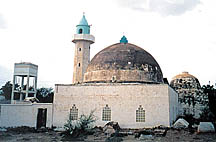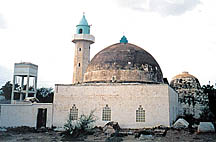
Intellectual Heritage for Bin Ojayl [Archives:2000/15/Culture]
April 10 2000
Saleh Abdulbaqi,
Yemen Times

Bin Ojayls’ Scientific Rank
Bani Ojayl were known for their high scientific and educational stature in religion and Islamic law sciences as well as in linguistic arts. They have served the dissemination of knowledge through teaching or holding their own scientific seminars attended by students of science. However, none of them has attained the rank of Bin Ojayl. He was the most illustrious for his mastery of jurisprudence, religious duties, Hadith, Grammar and scholasticism. Therefore, he became so well-known that scholars from various places came to attend his classes. In one word, he was an encyclopedia and a proficient teacher. He was skilled in communicating his thoughts and ideas to his students. There is a famous story which Al-Shargi, Al-Khazragi and Al-Yafye’e have talked about and was told by the well known historian Al-Jondi. There was a man who used to live in the mountains. One day he came to Sheik Ahmed Bin Mousa Bin Ojayl to ask him on several matters concerning jurisprudence, religious duties and language science. So he attended his class and started asking him about those matters to which he got very satisfactory answers.
However, the Sheik abstained from answering his questions regarding speech and asked to wait for some time. After the end of the class he explained to him that these questions would require discussions that might have confusing impact on other students. Then, he started answering his questions with full satisfactory answers. After this incident the man held Bin Ojayl in high esteem.
Sheik Bin Ojayl had always taken into consideration the students’ intelligence levels in delivering his lectures. This is why he asked that man in the above story to wait until the end of the class. He was also very concerned about teaching and disseminating knowledge. Al-Khazragi said a lot in this regard: “Different students from different places learned at the hands of Bin Ojayl. His method of teaching was more like blessing because he was meticulous in this regard.” And in another section he stated: “He is one of the most blessed jurists in Tihama in teaching and many have learned from him.”
There used to be a colloquium held every year in Rajab when scientists and jurists of Bait Al-Fakeeh and Tihama would gather in the Grand Mosque. There they would read ‘Saheeh Al-Bokhari’ and discuss some of the matters regarding this book. It is said that Bin Ojayl was the one who established this colloquium which became a permanent institution in the city itself. You would find people in houses and in mosques read ‘Saheeh Al-Bokhari’ along with ‘Saheeh Muslim’ and Qur’an construction all through the year. In general, we can say that Bin Ojayl’s interest in knowledge, disseminating education and teaching were not for ephemeral, mundane reasons. Nobody can deny this. For this reason, Bin Ojayl had set the basics and principle of his educational and worshipping curricula as well as the pillars of his educational philosophy, some of which are:
1. Honest worship and asceticism in one’s religious life is spiritual education.
2. Self-dependence, uprightness and going in for legitimate profit.
3. Science is a benefaction and disseminating for God’s sake is a way to thank him for it.
4. Taking good care of students.
5. Taking into consideration the student’s intellectual ability as well as encouraging him on pursuing education.
6. The scientist should live the people’s problems and work hard to help them and defend them against tyranny.
Some of his contemporaries were the jurists Abdullah Bin Ahmed Joma’an, Sheik Mohammed Ya’akoub Al-Sawdi, Ismail Al-Hadrami (died 688 A.H.), Abu Al-Saft Ismail, Sheik Ahmed Bin Elwan. However, there are no proofs that there was any kind of communication between Sheik Bin Ojayl and his contemporary scientists and jurists. However, judge Ya’akoub Yousif Al-Jondi (father of the historian Baha Al-Deen Al-Jondi) was used to visit Bin Ojayl so often.
Scientific Titles
Sheik Ahmed Bin Ojayl was well-known by the title “Abu Al-Abbas”. However, some manuscripts suggest that he might have been called “Abu Al-lafeef” as described by Mohammed Ahmed Al-Kattan. The public, however, used to call him “Abu Yahya” as is usual in calling a person by the name of his elder son. Those various titles show us that his scientific rank was appreciated by every body and that was why he was given several titles such as: Shihab Al-Deen, Al-Imam Al-Allamah, Allamat Al-Sham Wa Al-Yemen, Kotb Al-Yemen and many others.
Political Aspects of Bin Ojayl’s Epoch
The ruling of Bani Rasool continued from 626 A.H. to 690 A.H. This latter is the date when Bin Ojayl died (4 years before the death of the King Al-Modafar). Bin Ojayl lived during the rule of King Al-Mansour Yousif and his son Al-Modafar. This period was known for its stability because of the absence of any tribal, political and doctrinal disputes. This was clear by the rapid educational and scientific development Yemen was undergoing during that period.
Some people ask what was the approach of Bin Ojayl towards the decaying conditions and the ruling of kings? Many people claim not to have heard that he had ever opposed or fought against the kings of Bani Rasool although Tihama, especially Al-Ma’azebah tribe, were being irritated by the princes of Bani Rasool. Was he just asking for mercy for poor people? We say that Bin Ojayl has never led any opposition against the government, although he was popular and trusted among the public because he knew it was wrong to do so even if the ruler was a tyrant. He held to this attitude because he was afraid that there would be sedition and he also wanted to prevent people from being killed. However, we would like to say that during the period 628 – 694 A.H. (during the rule of King Al-Mansour and his son Al-Modafar) the conditions were stable and secure. For this reason, Bin Ojayl, along with other jurists, did not lead revolutions against rulers. All that they did was rendering advice, condemning the wrong deeds and intercession. However, after the death of King Al-Modafar the area had been ravaged by several troubles and disorders, which gave birth to opposition.
His asceticism, modesty and social status
Bin Ojayl was known for being ascetic, pious and modest. He farmed his land himself and fed his family from what he earned. He always wanted to be like ordinary people and, therefore, kept himself away from rulers. Many scientists in his time were trying to be closer to rulers hoping for rewards or high positions. Bin Ojayl was not like many others because he was not looking for rewards and positions. There was a time when he was offered the post of judge, but he declined because he wanted his knowledge to be available to his students and the public. Al-Khazragi has mentioned several cases that prove his modesty and love for simplicity. One day he went to Mecca and wanted to go around Al-Ka’abah; People came running to him, kissing his hands for blessing. He told them that they were in God’s worshipping spot, but that only made them more insistent. The modesty of this jurist won him the love and respect of people. Abu Dahish said the rank of Bin Ojayl was very high and nobody has attained such a rank in that epoch. Besides, he was the first to render Bani Ojayl a rank superior to them.
Intellectual Heritage for Bin Ojayl
Al-Khazragi, Al-Shargi and Al-Yafe’ei stated that Bin Ojayl had written books in jurisprudence and Hadith, but they did not mention whether they exist or not. The author tried to ask people who have interest in such subjects, but nobody could lead him to these books except for one poem captioned “Garat Bin Ojayl” that was found in a library in Berlin, Germany. There is a possibility that his books had been transported outside Yemen among many other books and manuscripts which are distributed in different libraries around the world. There are also some who say that some manuscripts were found in Bait Al-Fakeeh and in some scientists’ personal libraries, but Al-Imam Ahmed Bin Hameed Al-Deen gathered all those manuscripts when he entered Bait Al-Fakeeh after his war with Al-Zaraneek. Then, he chose whichever he thought were valuable and took to Sana’a and Hajja. As for the rest, they were put in a cupboard in Bait Al-Fakeeh Mosque and the key was given to a scientist who was responsible for taking care of them and the key is still with this family. There is, however, one book of his which was found in Sana’a in the Grand Mosque titled ‘Majmo’o Al-Salawat Al-Khams’. This is the only book written by him that we could find. I think it is time that the Heritage Department of the Ministry of Education discharged its responsibilities and duties in protecting whatever is left of our educational heritage.
The death of Bin Ojayl
Options differ regarding the exact date of Sheik Bin Ojayl’s death. Al-Khazragi, Ahmed Al-Akili, Omar Rida and the orientalist Brokelman have stated that he died on the 25th of Rabi’i Al-Awal 690 A.H. However, Brokelman has only mentioned the year without mentioning the day and the month. Therefore, it is roughly estimated that he died between 689 and 690 A.H. We found some sources mentioning that he died when he was 84 years old and therefore, reckoning that he was born in 606 A.H., we can say that he died in 690 A.H. It is also mentioned that King Ibrahim Bin Al-Modafar attended his funeral and lowered him into his grave, an incident that aroused the envy of the king’s entourage and princes. This is also another indication of the high esteem Bin Ojayl’s enjoyed and that all people respected him. It is said that he was buried in Bait Al-Fakeeh.
We in the Yemen Times have photographed the grave of this Sheik and made sure that he was buried in the same place that he lived in. It is located 3 km to the northwest of Bait Al-Fakeeh in village known today by “Al-Turbah’. That was the place where he lived, originally called “Katheeb Shawkah”. Now, many people, tourists and orientalists visit his grave which is located near a mosque named after him. As for the white stone that lies near the grave, there is a strange story about it which I would talk about in the next edition under the title “The Legend and the Myth”.
——
[archive-e:15-v:2000-y:2000-d:2000-04-10-p:./2000/iss15/culture.htm]


